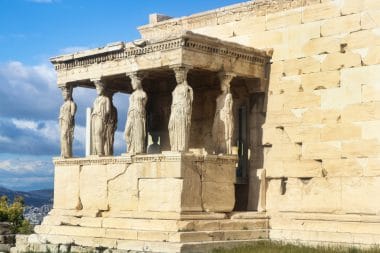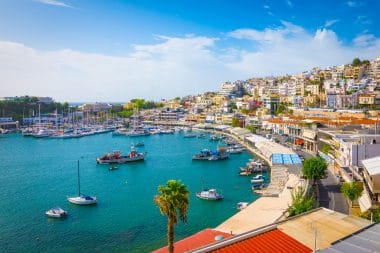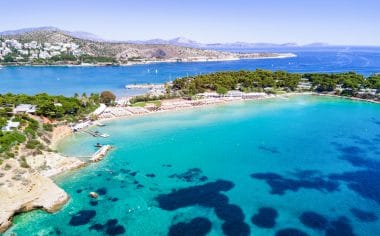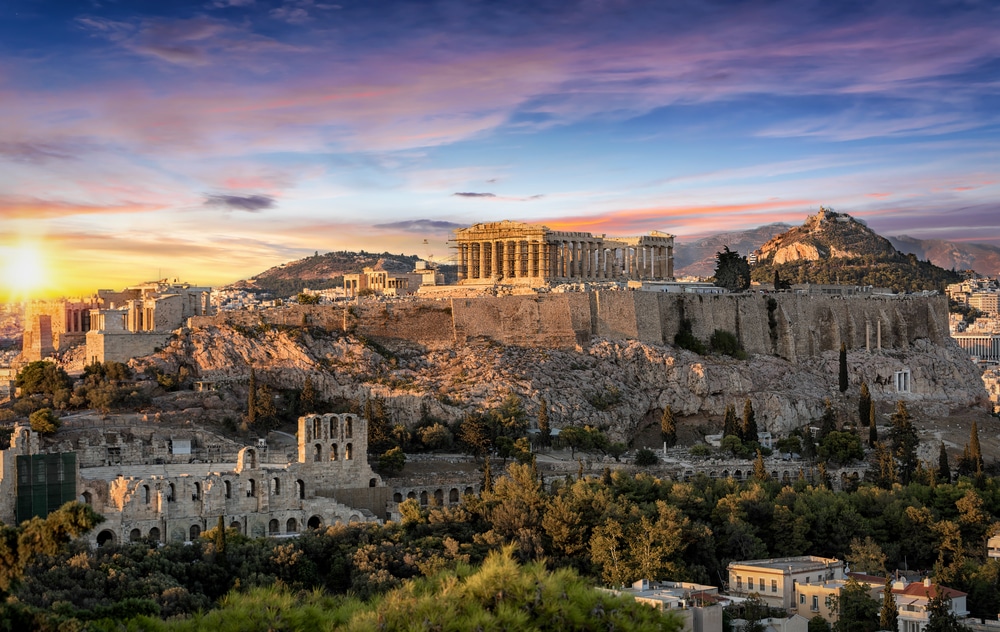The birthplace of European philosophy, theatre and art – this is ancient Athens! 150 years ago, the Athenians lived among the ruins of the Acropolis, today streams of tourists pass through here. The life of a modern city rages around the historical backdrop. However, with atmosphere – because here the very own attitude to life of the inhabitants characterises the city on the edge of Europe, where not only writing and music are different from the rest of the continent.
Curtain up: Athens – a shining legacy of a great past

The Athenians have always been idiosyncratic. Thus, they introduced democracy as early as pre-Christian centuries. Their heart beats in the Pnyx, the site of the People’s Assembly. Since the reforms of Cleisthenes around 510 BC, every free male citizen of Athens over the age of 30 has been allowed to participate. Today, holidaymakers and school classes sit here every evening. As part of a light spectacle, they eagerly follow the stories about the construction history of the Acropolis.
The writer Edgar Allan Poe once lamented the “disappearance of the glory of Greece”. But this glory is still there: temples, sanctuaries and statues still stand in all parts of the country. Only the gods and goddesses are dead. Admittedly, most temples are only ruins, the heads and limbs of the figures are missing. Nevertheless, its fundamental beauty has survived the past centuries.
The historical heritage of antiquity lives on. Athens is home to the oldest masterpieces of European architecture and art.
Crown witness of antiquity – the Acropolis
On a rugged rock high above Athens rises the Acropolis, the religious center of the city of Athens. The Temple Mount of the Acropolis with the Parthenon Temple dominates the cityscape in the center of Athens, the capital of Greece.
At the foot of the Acropolis is the New Acropolis Museum. Many ancient finds are presented in a dignified manner via a spacious forum.
Temples, markets and theatres in Athens – at a glance:
- The Dionysus Theatre played a very important role in Athens in classical antiquity. The theatre on the southern slope of the Acropolis is considered his birthplace.
- North of the Acropolis, the Agora formed the center of ancient everyday life.
At its edge stands the best-preserved temple in Greece. There were also important official buildings as well as altars and temples for many other deities. - In the Kerameikos cemetery, graves give an impression of how death was dealt with in classical times. Many originals are exhibited in the Archaeological Museum.
- Under Emperor Hadrian, the monumental temple of Olympian Zeus was built in 130 AD. Even today, huge columns bear witness to the former splendour.
- The smallest temple, that of the goddess of victory Nike, was probably the last of the ensemble to be built. Parts of the altar can still be seen today.
- Earthly defensive on the outside, a shiny golden reflection of heaven on the inside – the monastery church of Dafni. It is the most magnificent and art-historically valuable church in Athens. About 10 kilometers west of the city center, it stands in a pine forest.
But in addition to the testimonies of this great past around the ancient settlement area of the Acropolis, there is also modern Athens.
In the heart of the city – living in modern Athens

Chaos is part of the charm of the Greek capital. Traffic jams are not only caused when the yellow trolleybuses jump out of the overhead lines. Or a driver in an alley that is far too narrow has a conversation that is far too long with a passer-by who happens to be passing by. The traffic jams are part of everyday life, like the pedestrians who prefer to cross the road when the light is red rather than green. And the tiny parking lots where the cars are parked close together. You can actually only leave your place if all parkers return at the same time. But even in chaos order becomes recognizable:
A visit to the attractive old town district of Plaka is popular. Surrounded by classicist villas of the 19th century, there is a very special atmosphere here. In the narrow alleys, often connected by stairs, restaurants, quaint pubs and bars are lined up next to countless souvenir shops.
Right next to the old town district is the former merchants’ and craftsmen’s quarter Psirri. The many restaurants and street cafés are very lively.
Syntagma Square is the heart of the city. The parliament building, built from 1836 to 1840, is worth seeing. The classicist building was built as a royal palace for Otto I, who was elected King of Greece in 1832 after a series of diplomatic entanglements. In front of the building, soldiers in historical costume carry out the hourly changing of the guard.
Nearby are the almost 120-year-old market halls, where hundreds of stalls sell poultry, meat and fish.
An Aegean Overture – Excursion to the Islands in the Saronic Gulf

On three sides, Athens is surrounded by the more than 1000-meter-high mountain ranges of Hymettos, Parnes and Pentelikon. To the southwest, the view sweeps far out to the Saronic Gulf. Yachts, ferries, hydrofoils and even cruise ships cross it. The island of Aegina stands out clearly against the silhouette of the Peloponnese . In ancient times, the island was one of Athens’ main economic competitors. Today, the island is a popular destination for Athenians. From the port of Piraeus , the hydrofoil crossing takes only 50 minutes – and you’re in another world.
No less exciting is a trip to the island of Poros with the town of the same name. At the exit of the gulf, the island nestles very close to the coast of the Peloponnese. The crossing takes about 80 minutes. There is no visual boredom. Soon the olive, lemon and orange groves greet you from the shore of the mainland. In the background, the Ortholithi peak rises over 1100 meters high. Then the Sound narrows to a 250-meter-wide canal. The harbour front of Poros is lined with restaurants, cafés and cosy taverns.
Soon the coast of the island of Hydra appears. Cats and donkeys are waiting for arrivals on the quay. The car-free island captivates with old captain’s houses that stretch far up the steep slopes like the tiers of an amphitheater.
On the way back, you will pass the temple of the pagan sea god Poseidon. It is one of the most atmospheric experiences to watch the sun set through its slender columns between land and sea.

Good to know: Ancient Athens was a city of pedestrians. Even today, you can easily get to know the archaeological sites during a one-day city tour. For the visit to the Archaeological Museum, you should plan half a day more.
This journey also comes to an end. Probably the most beautiful farewell is the view from Mount Likavittos. At 277 meters, Likavittos is the highest elevation and at the same time the local mountain of Athens. From its rocky peak, there are breathtaking views over Athens and the Saronic Gulf. The top of the mountain is adorned with a picturesque, whitewashed chapel with many turrets. This impression has a lasting effect. If you like, you can linger for a while in the mountain restaurant.
Tip: A funicular runs up through a tunnel in the rock.
Piraeus – The Port of Athens

If you take it very seriously, Piraeus is actually just the port of Athens. Since ancient times, however, the district has developed into its own small town, which today offers a variety of sights and also exudes its own flair. While the port has experienced several ups and downs over the centuries, it is now a popular destination for people who have set Athens as the destination of their trip. The beautiful natural harbour not only offers a great view of the coasts of Athens and Greece – it is worth taking a moment to immerse yourself in the district.
From war port to hub for global trade
Originally, it was the Athenians who established this area as the new location for the city’s port as early as the 5th century BC. Due to its natural position and the fact that there were several natural harbour basins here, it did not take much work to develop the peninsula into an important port of antiquity. The master class of Greek architects was already evident in ancient times: Piraeus was connected to the heart of Athens by a five-kilometre-long wall. This guaranteed the traders safe transport of their goods between the port and the city. Remnants of this wall can still be seen today in various parts of Athens and Piraeus.
In the various wars between Athens and its neighbours, the port naturally played an important role. Interestingly, after the fall of ancient Athens, the importance of Piraeus hardly dwindled – quite the opposite. One can almost be sure that it was only thanks to Piraeus that the city did not temporarily disappear completely into insignificance. Even today, Piraeus enjoys a special position. The port is considered Europe’s biggest attraction for cruise tourists and is also one of the most important European ports when it comes to trading goods.
What you should see while visiting Piraeus?
Even though Piraeus is officially only a district of Athens, the size of the area should not be underestimated. It can be worth planning a day or two to deal with this part of the Greek capital on your own. Of course, the harbour itself is the centre of the sights. For example, there are various museum ships that can be found directly in the harbor basin. The Trokadero Marina Ship Museum offers a replica of an ancient Athenian trireme, the Georgios Averoff – an old armoured cruiser – and the freighter Liberty. All of them tell of the long history of shipping in the port and the activities of the Greeks.
Over the centuries, the image of the port has of course changed. Today, much of it is an industrial complex that is of great importance to the Greek economy. Nevertheless, traces of history can still be found, especially in the center of Piraeus. The town hall square and town hall are impressive – as is the church of Agia Triada, which can be found right here. In the first few minutes, you will also smell the smell of fresh seafood, which is offered everywhere in the surrounding restaurants. You won’t get the seafood fresher even in Athens, which is so seafood-affine.
The port itself is actually divided into three separate areas. The Zea marina and the main port are the points where the most activity can be noticed. Traders, tourists, locals and visitors from the cruise ships can be seen everywhere in the streets and flock to the restaurants and small shops that dot the area. If you want to escape the hustle and bustle a little, you should go to the small port of Mikrolimano. For a moment it seems as if you are in a small island here and the buildings at the harbor are a sight in themselves.
Kastella Hill is a special destination for tourists. The approximately 80-metre-high elevation – which is of course crowned by a church – offers the best view over the entire harbour area. From here you can also see the many cruise ships, which can actually be found at any time of the year in the deep waters off the actual harbor.
Experience culture, nature and gastronomy in the port of Piraeus
Even though it is still a hub for international trade, Piraeus is also a vibrant neighbourhood that is partly becoming an in-district for Piraeus’ young population. Performances by artists are just as normal as concerts in the small bars and restaurants that are located around Piraeus. These are also an important reason for the many visitors. Here you can find the best seafood in town – and you don’t even have to go to Varoulko Seaside, a Michelin restaurant. It is above all the many taverns that exude a very original charm and have one or the other treasure from the sea on the menus.
Finally, a walk around the Peiraiki peninsula is also worthwhile. In an hour, you can walk around the port area and enjoy a view of the sea that is not blocked by ships or buildings. Here you quickly realize why the Athenians once chose this area for their port and why Piraeus still enjoys great popularity among the locals today


